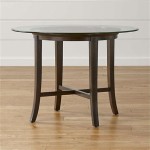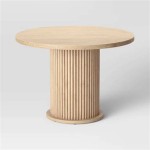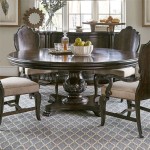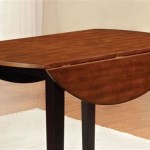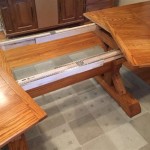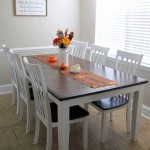Refinish Dining Room Table Top: A Guide to Renewing Your Furniture
A dining room table is a centerpiece of any home, a gathering spot for family meals, celebrations, and cherished memories. Over time, the table's surface can endure wear and tear, losing its original sheen and beauty. Refinishings provide a solution to rejuvenate the table, restoring its charm and enhancing the dining room's ambiance. This comprehensive guide will delve into the process of refinishing a dining room table top, covering essential steps, considerations, and techniques for achieving a professional finish.
Step 1: Preparation and Stripping
Proper preparation is crucial for a successful refinishing project. The first step involves thorough cleaning of the table top to remove dust, grime, and any existing wax or polish. A mild detergent mixed with warm water is suitable for this purpose. After cleaning, allow the surface to dry completely. Next, the existing finish must be stripped to reveal the bare wood. Depending on the type of finish, different stripping methods may be required. Chemical strippers are effective for removing old paint or varnish, but they should be used cautiously, following the manufacturer's instructions. For stubborn finishes, a scraper or sanding block can be employed. While stripping, wear protective gear such as gloves, eye protection, and a mask.
Step 2: Sanding and Smoothing
After stripping, the table top needs to be sanded to achieve an even and smooth surface. Start with coarse-grit sandpaper (80-120 grit) to remove any remaining residue or unevenness. Gradually progress to finer grits (120-220 grit) for a smoother finish. Sanding should be done in the direction of the wood grain to avoid scratches. Remember to sand the edges and corners carefully to prevent sharp edges. Once sanding is complete, wipe away any sanding dust with a tack cloth. This step ensures a clean and dust-free surface, essential for a successful finish.
Step 3: Staining and Finishing
The choice of stain and finish depends on the desired final appearance and the table's style. Stain adds color and depth to the wood, enhancing its natural beauty. Various types of stains are available, such as oil-based, water-based, and gel stains. Oil-based stains penetrate the wood deeply, offering rich color and durability. Water-based stains are easier to clean up but may not penetrate as deeply. Gel stains are thick and can be used to enhance the wood's texture. After staining, apply a sealant or finish to protect the wood from moisture, scratches, and stains. Choices include polyurethane, varnish, shellac, or wax. Polyurethane is durable and resistant to water and scratches. Varnish provides a protective barrier with a glossy finish. Shellac is a natural sealant known for its durability and ease of application. Wax offers a natural finish that enhances the wood's texture and beauty. Apply the finish in thin coats, allowing each coat to dry thoroughly before applying the next. Follow the manufacturer's instructions for drying times and number of coats.
Step 4: Finishing Touches
After the final coat of finish has dried, inspect the table for any imperfections or blemishes. Use fine-grit sandpaper (400-600 grit) to smooth out any rough spots or unevenness. Lightly polish the surface with a soft cloth to enhance the shine and remove any dust particles. For a professional-looking finish, consider applying a coat of furniture wax. Wax provides a protective layer and adds a warm glow to the wood. Apply the wax with a soft cloth, working it into the wood's grain. Let the wax dry for a few hours before buffing it with a clean cloth. Once finished, admire the revitalized beauty of your dining room table top.
Refinishing Considerations
Before embarking on the refinishing process, it's essential to consider several factors. The table's condition, type of wood, and existing finish play a significant role in determining the refinishing techniques and materials required. For example, a heavily damaged table may require more extensive stripping and sanding than a lightly worn surface. The type of wood influences the choice of stain and finish, as different woods react differently to various treatments. Additionally, the existing finish's type and condition affect the stripping process and the choice of new finish. It's best to consult with a professional restorer or furniture specialist for personalized advice based on your table's specific needs.
Safety Precautions
Refinishing involves working with chemicals and tools that require safety precautions. Wear gloves, eye protection, and a mask to protect yourself from harmful fumes, dust, and chemicals. Work in a well-ventilated area, as fumes can be hazardous to your health. Always follow the manufacturer's instructions for using stripping chemicals and finishes. Keep children and pets away from the work area to prevent accidents and exposure to toxic substances.

Refinishing A Dining Table Diy Beautify Creating Beauty At Home

How To Refinish A Table Sand And Sisal

Diy Refinished Dining Table Top Redhead Can Decorate

How To Refinish A Table Sand And Sisal

Diy Refinished Dining Table Top Redhead Can Decorate

Dining Table Re Makeover White Lane Decor

How To Refinish A Worn Out Dining Table

How To Refinish An Antique Dining Set The Wild Decoelis

How To Refinish A Dining Table Shades Of Blue Interiors

Dining Room Table Makeover Refinishing A Wood Veneer Stacy Risenmay

